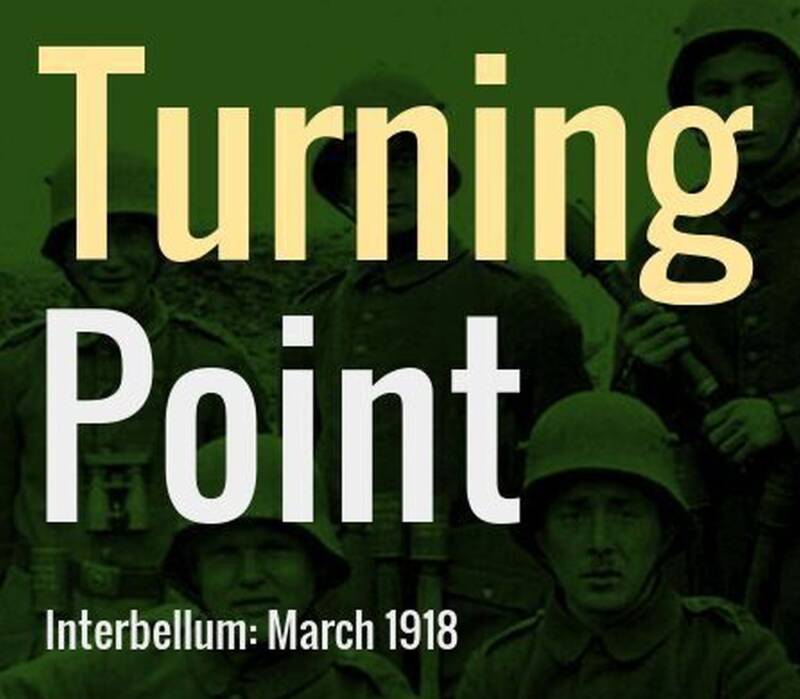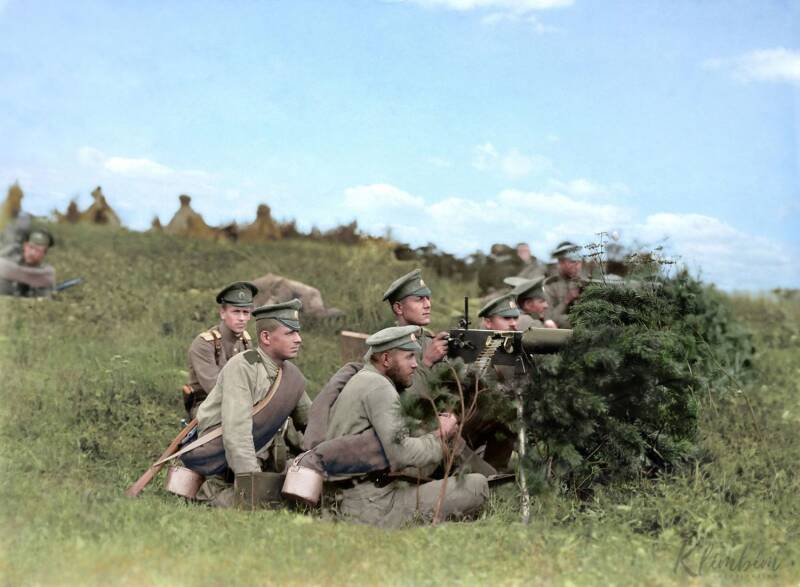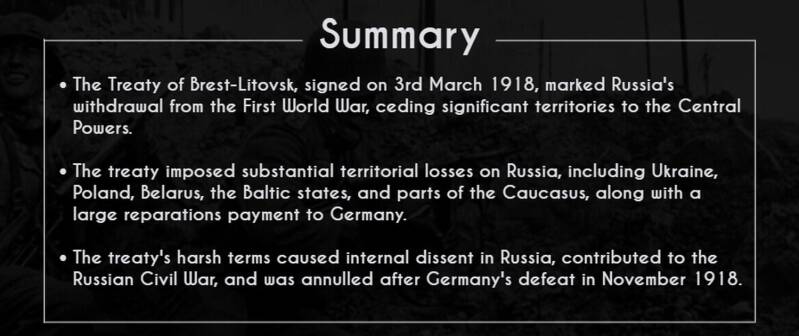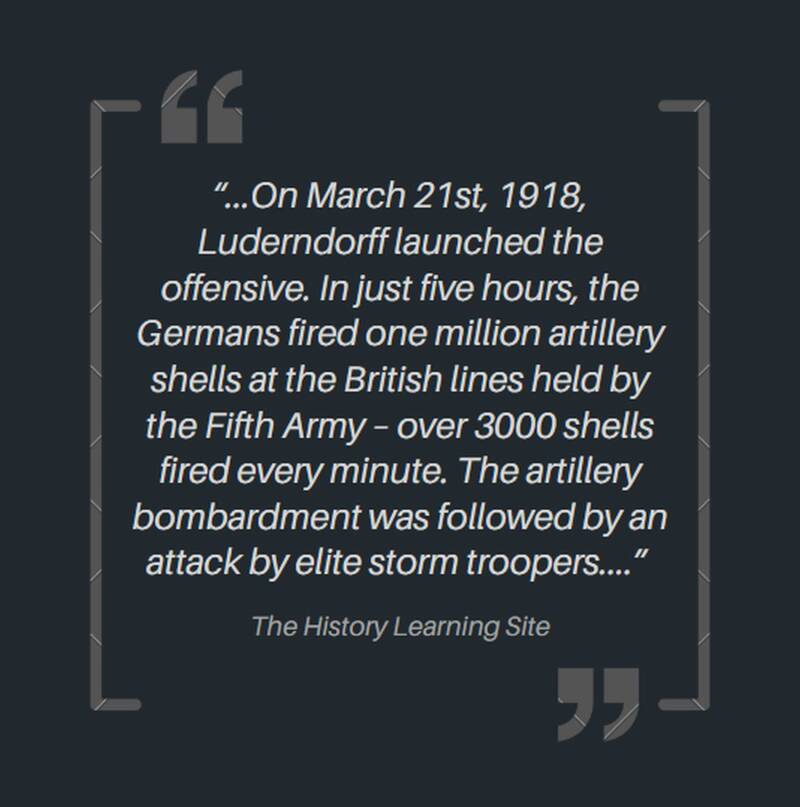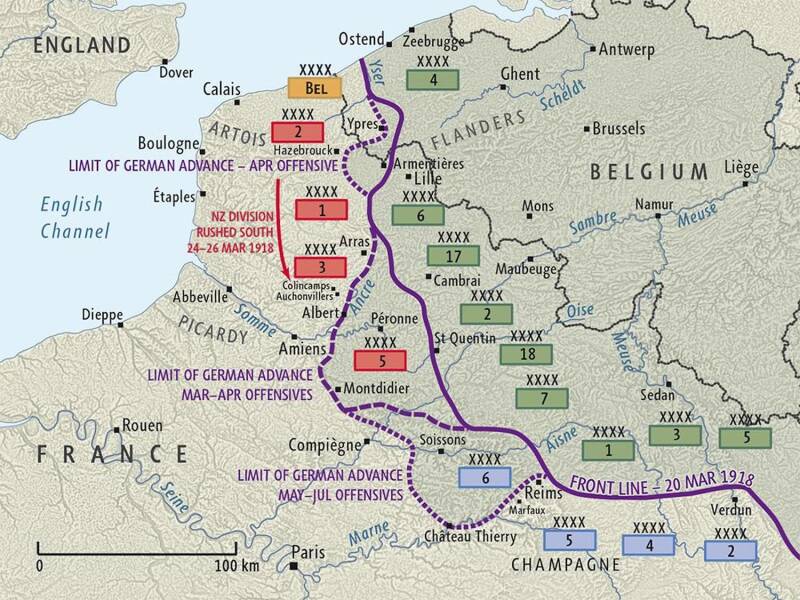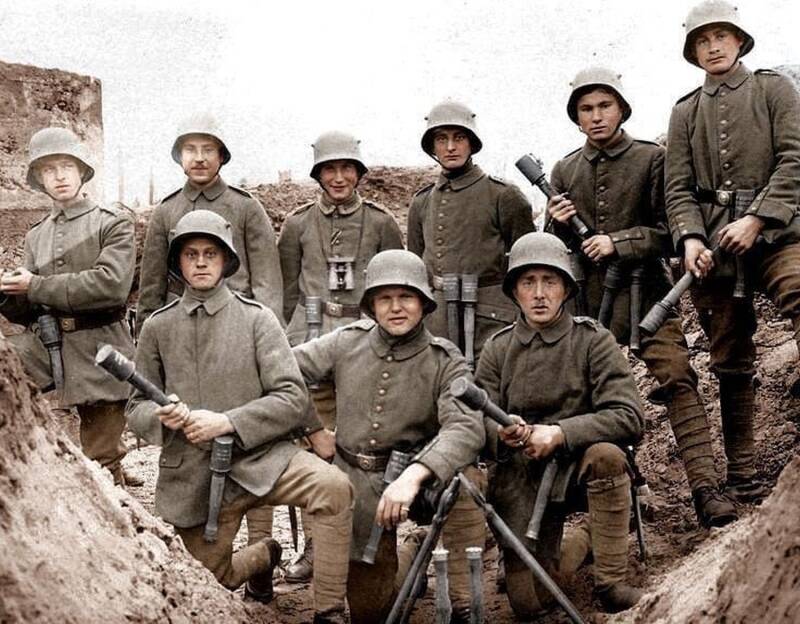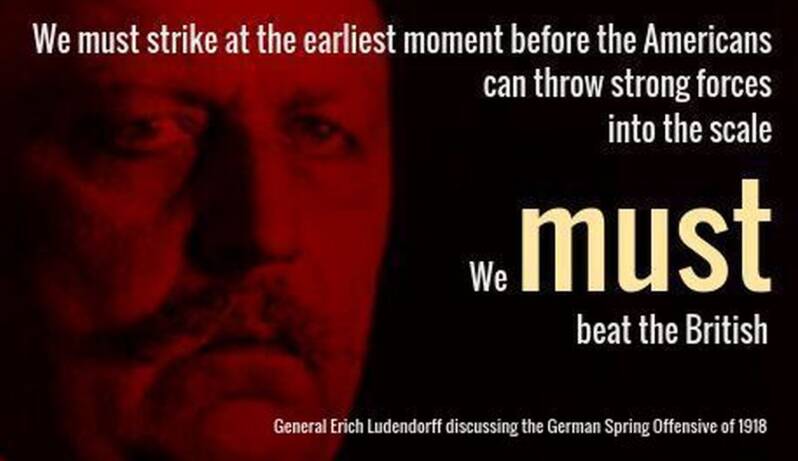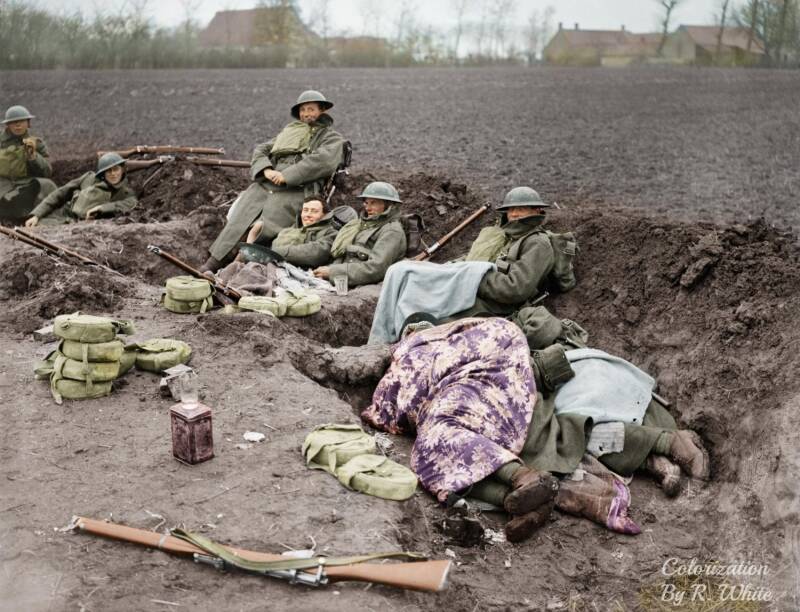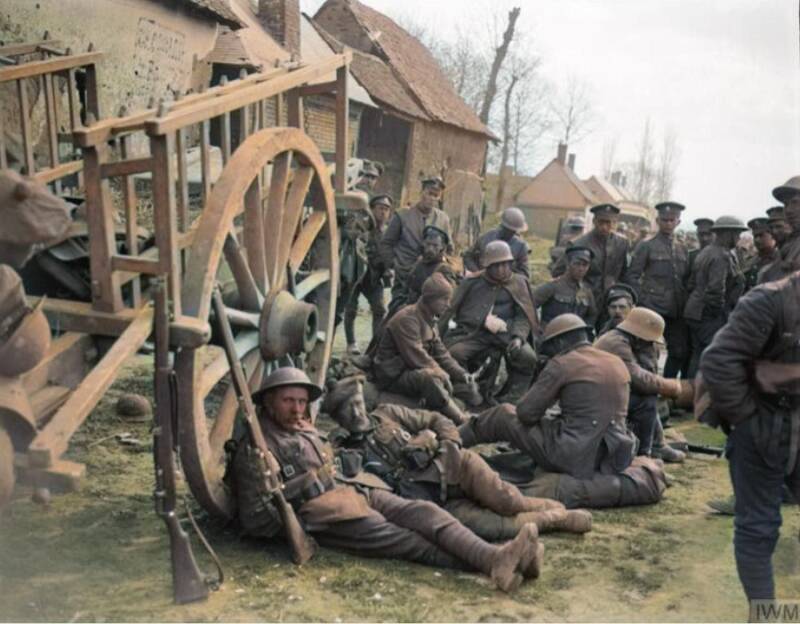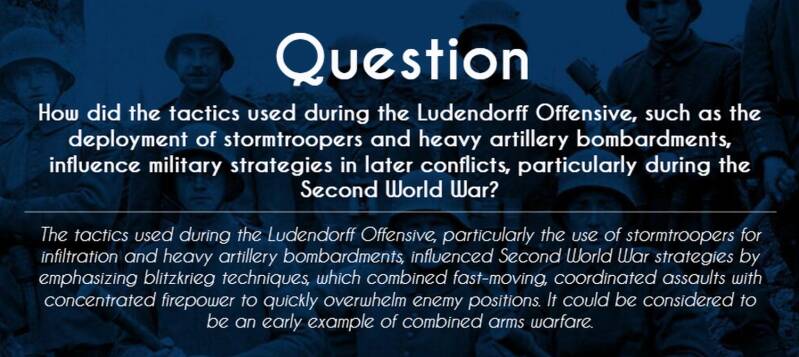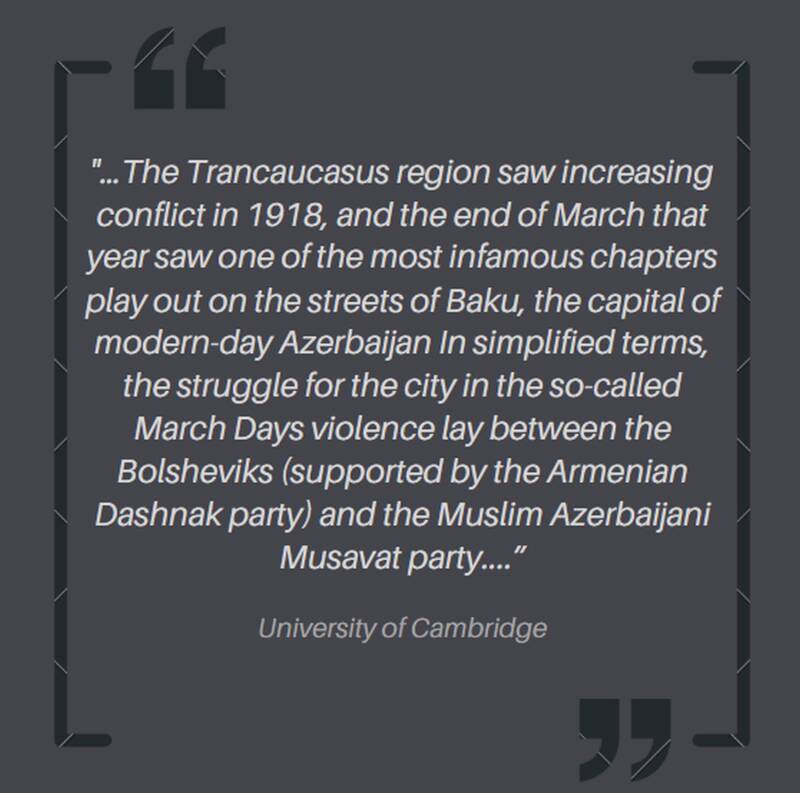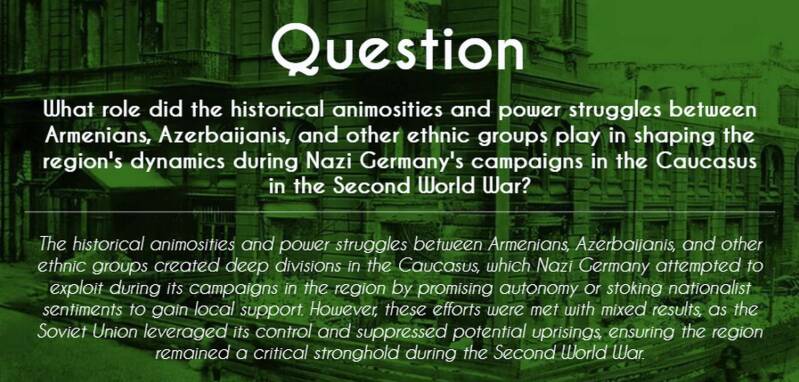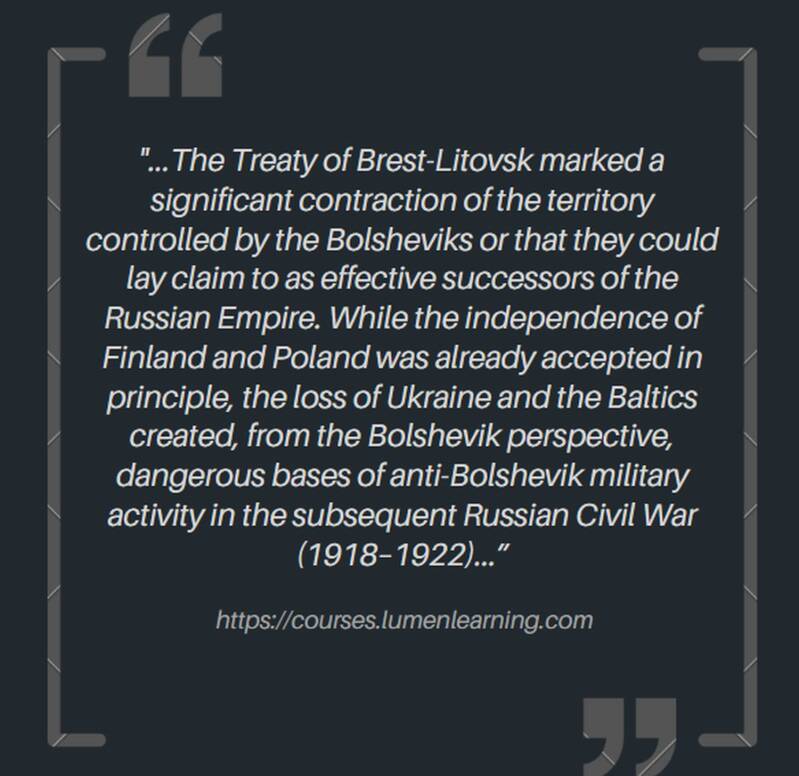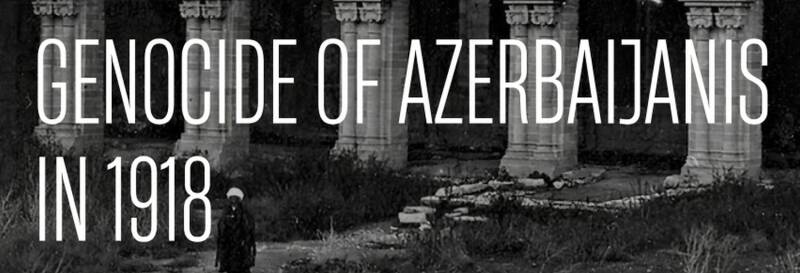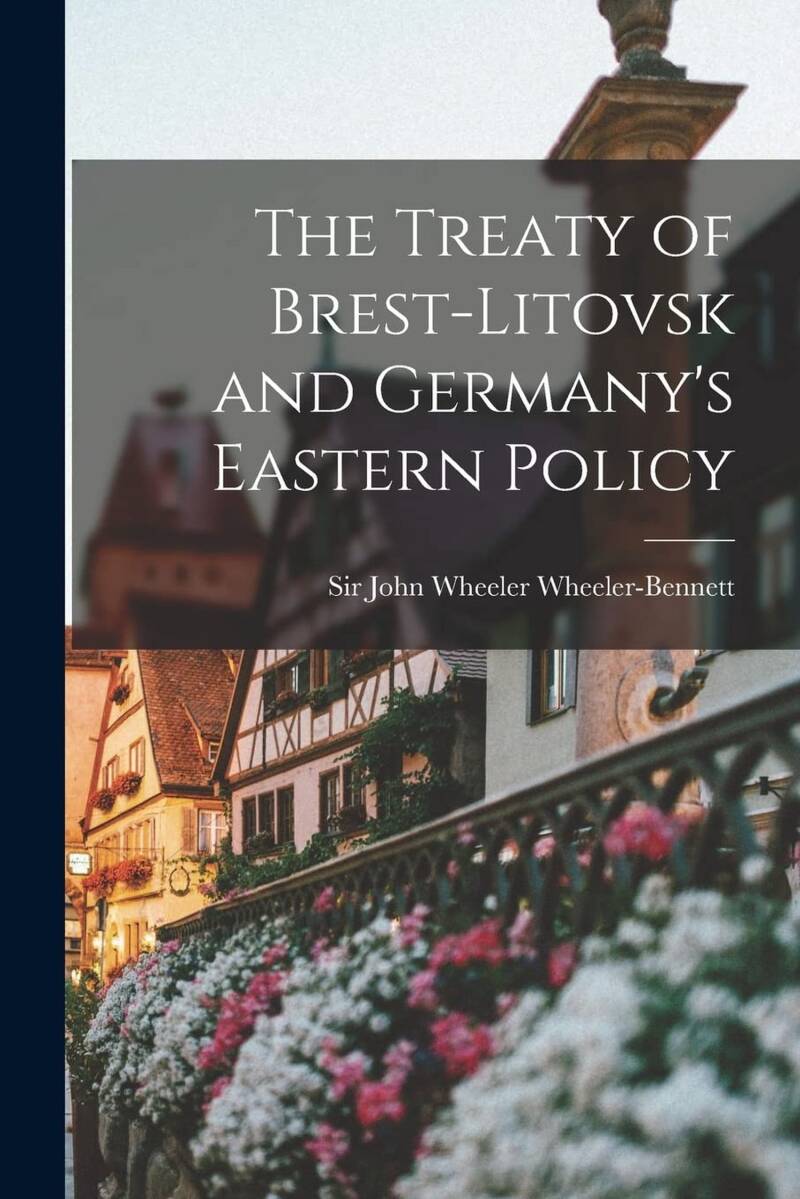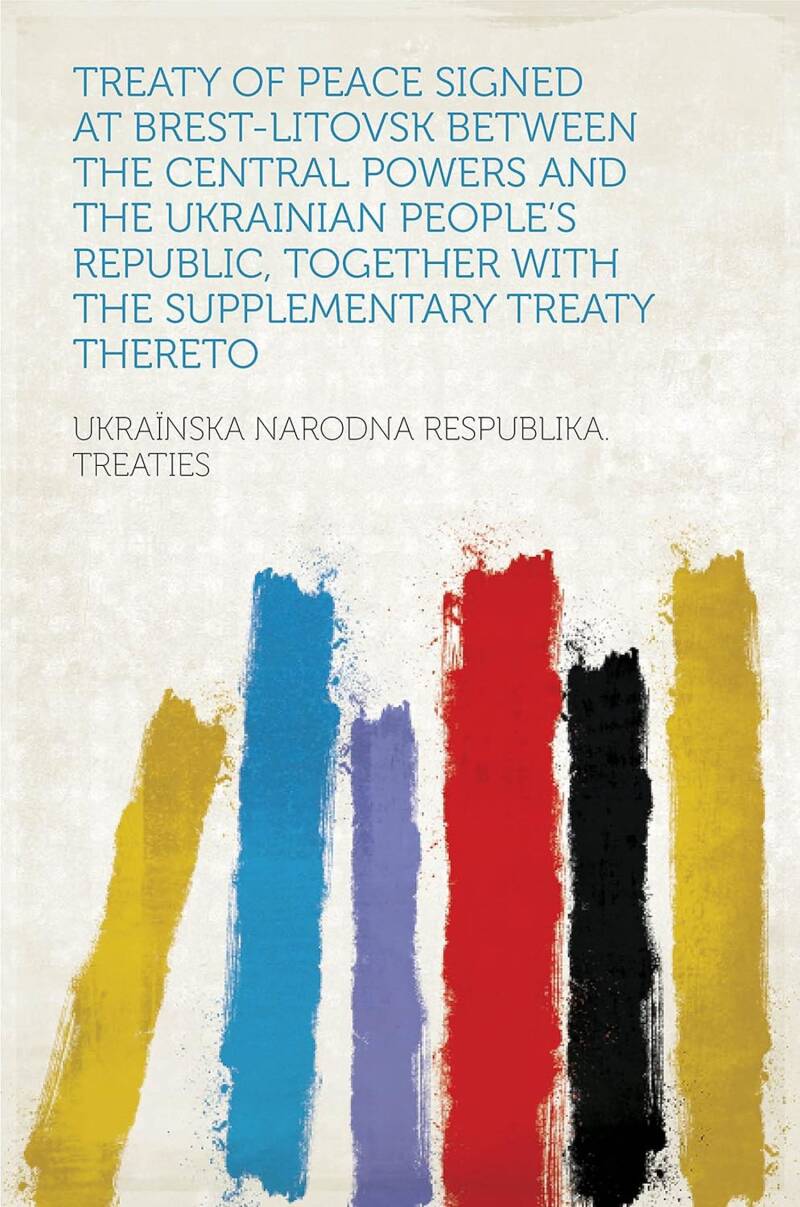The Final Gamble
Russia's exit and a desperate German offensive
March 1918 was a pivotal month during the First World War, marked by significant military and political events. The most critical development was the launch of the German Spring Offensive, also known as the Ludendorff Offensive, on the 21st March.
This offensive was Germany's final major attempt to break the stalemate on the Western Front before American forces could fully deploy.
The Germans initially succeeded, advancing rapidly and threatening the Allied lines, but the offensive ultimately failed to achieve a decisive victory.
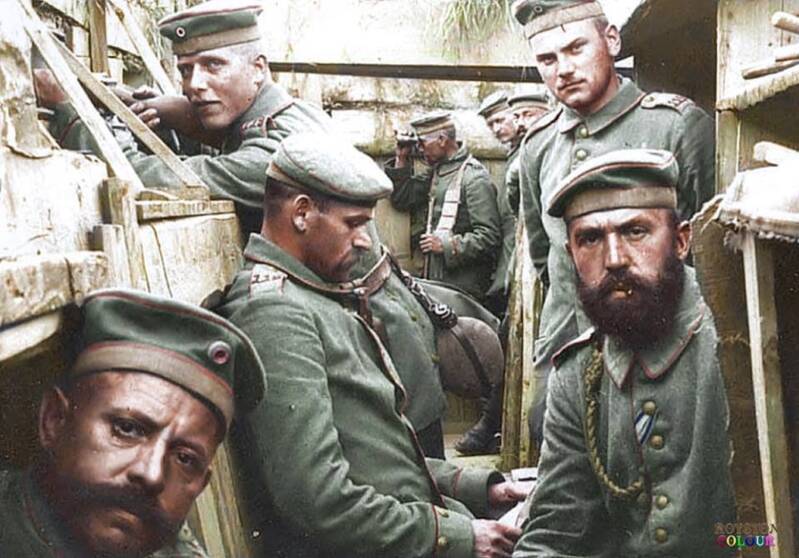
German soldiers in a trench during the First World War. The Germans launched the Spring Offensive in 1918 to secure a decisive victory before American forces fully arrived in Europe. Facing dwindling resources and a blockade, they aimed to break the stalemate and force the Allies into peace negotiations.
...boosting their forces...
Another key event was the signing of the Treaty of Brest-Litovsk on the 3rd March between Soviet Russia and the Central Powers.
This treaty ended Russia's involvement in the war, allowing Germany to transfer troops from the Eastern to the Western Front, significantly boosting their forces for the Spring Offensive.
The treaty also resulted in significant territorial losses for Russia, including Ukraine, Belarus, and the Baltic states.
Russian Empire, military exercises: Machine gun position, 1914. Four years later, the Treaty of Brest-Litovsk would facilitate Russia's exit from the First World War.
Photographer: Karl Bulla
https://flashbak.com/captivating-colorized-portraits-of-russian-fighters-in-world-war-1-411895/
...committed to bolstering the Allied war effort...
In the political arena, British Prime Minister David Lloyd George faced criticism over the war’s conduct, leading to debates in the British Parliament.
Meanwhile, in the United States, preparations for sending more troops to Europe intensified as the country committed to bolstering the Allied war effort.
These events in March 1918 set the stage for the final phases of the First World War, highlighting the desperation and high stakes on all sides.
Treaty of Brest-Litovsk, 3rd March 1918
The Treaty of Brest-Litovsk, signed on the 3rd March 1918, between Soviet Russia and the Central Powers (Germany, Austria-Hungary, the Ottoman Empire, and Bulgaria), marked Russia's exit from World War I.
Negotiations began after the December 1917 armistice on the Eastern Front, with the treaty finalized at Brest-Litovsk (now Brest, Belarus).
The Soviet delegation, initially led by Adolph Joffe and later by Leon Trotsky, faced demands from the Central Powers for the secession of occupied Russian territories.
Photocopy of the first page of Brest-Litovsk Peace Treaty between Soviet Russia and Germany, Austria-Hungary, Bulgaria and Turkey, March 1918. From left to right the columns are written in: German, Hungarian, Bulgarian, Ottoman Turkish and Russian.
...Russia recognized Finnish independence and agreed to end hostilities...
Borders drawn up in the treaty.
Trotsky attempted to delay the talks, hoping for revolutions in Central Europe, but a renewed Central Powers offensive in February 1918 forced the Soviets to agree to peace terms.
The treaty imposed significant territorial losses on Russia, including Ukraine, Poland, Belarus, the Baltic states (Lithuania, Latvia, and Estonia), and the Caucasus regions of Kars and Batum. These areas accounted for 34% of Russia's population, 54% of its industrial land, 89% of its coalfields, and 26% of its railways.
Additionally, Russia recognized Finnish independence and agreed to end hostilities with the Ukrainian People's Republic. A supplementary protocol in August 1918 obligated Russia to pay Germany six billion marks in war reparations.
Signing of the armistice between Russia and Germany on 15 December 1917. Prince Leopold of Bavaria signing the treaty.
...saw Russia and Germany renounce all territorial and financial claims against each other...
The treaty was highly controversial in Russia, fueling the White movement and causing a split between the Bolsheviks and the Left Socialist-Revolutionaries, who withdrew from the Council of People's Commissars and later rebelled.
The treaty was nullified by the Armistice of the 11th November 1918, following Germany's surrender.
During the subsequent Russian Civil War, Soviet attempts to regain lost territories had mixed outcomes.
While the Red Army was defeated in the Baltic independence wars and the Polish-Soviet War, it succeeded in reclaiming Azerbaijan, Armenia, Georgia, and parts of Ukraine.
The Treaty of Kars (1921) affirmed the border with Turkey, and the Treaty of Rapallo (1922) saw Russia and Germany renounce all territorial and financial claims against each other.
German Spring Offensive 21st March 1918
The Ludendorff Offensive, also known as the German Spring Offensive, was a series of major German military campaigns launched in March 1918 during the First World War.
Named after General Erich Ludendorff, who was the Chief Quartermaster General of the German Army, this offensive represented Germany's last significant attempt to break the deadlock on the Western Front and secure a decisive victory before the United States could fully deploy its forces in Europe.
German 1918 spring offensives map. The German Spring Offensive of 1918 was a desperate attempt to break the Western Front stalemate. Initially successful, it saw rapid advances but ultimately faltered due to logistical issues, exhausted forces, and a resilient Allied defense, leading to Germany's eventual defeat.
https://nzhistory.govt.nz/media/photo/german-1918-spring-offensives-map
...achieved remarkable success...

A 1915 portrait of General Erich Ludendorff who oversaw the German Spring Offensive in 1918.
https://roadstothegreatwar-ww1.blogspot.com/2022/12/erich-ludendorff-successful-tactician.html
The offensive began on the 21st March, 1918, with Operation Michael, the first of five major assaults.
The goal was to divide the British and French armies, capture vital railway hubs, and force the Allies into negotiations.
Initially, the Germans achieved remarkable success due to innovative tactics, such as the use of stormtroopers—elite units trained to infiltrate and bypass enemy strongpoints, creating chaos behind the lines.
They also employed heavy artillery bombardments to soften enemy defenses before the infantry assault.
German Stormtroopers posing for a photograph with hand-grenades, March 1918. German stormtroopers during the 1918 Spring Offensive were elite units trained for rapid, deep infiltration behind enemy lines. They employed surprise, speed, and targeted attacks to bypass strongpoints, creating chaos and enabling initial German advances, though ultimately unsustainable.
...stretched thin and exhausted...
Within the first few days, the Germans made significant gains, advancing up to 40 miles in some areas and capturing tens of thousands of Allied soldiers.
This created a sense of panic among the Allies, leading to the establishment of a unified command under French General Ferdinand Foch to better coordinate the defence.
However, despite early successes, the offensive ultimately failed to achieve its strategic objectives.
The German Army, stretched thin and exhausted, could not sustain the momentum.
The lack of logistical support, supply issues, and stiffening Allied resistance gradually halted the German advance.
The Allies, reinforced by fresh American troops, were able to regroup and launch counterattacks.
British soldiers of the 51st Division resting in a hastily dug trench in a ploughed field near Locon during the German spring offensive, 10 April 1918. The German Spring Offensive initially caused significant disruption and heavy casualties among Allied troops, forcing rapid retreats and creating panic, but ultimately led to a more unified and resilient Allied response, bolstered by reinforcements.
...demonstrated the futility...
The Ludendorff Offensive marked the beginning of the end for Germany in the so called 'Great War'.
It depleted Germany's manpower and resources, leading to a series of Allied offensives later in 1918 that ultimately resulted in the Armistice in November.
The failure of the Ludendorff Offensive demonstrated the futility of attempting to achieve a decisive victory through military force alone as the war had fundamentally shifted towards attrition and endurance.
German prisoners, some of them wounded, and British infantrymen resting on the roadside in Bouzincourt, 26 March 1918.. The failure of the German Spring Offensive in 1918 stemmed from overextended supply lines, exhausted troops, and stiff Allied resistance. Despite initial successes, the offensive couldn't achieve a decisive breakthrough, depleting German resources and morale, paving the way for Allied counterattacks.
The Belarusian People's Republic declares independence, 25th March 1918
The Belarusian People's Republic (BNR), also known as the Belarusian Democratic Republic, was proclaimed by the Council of the Belarusian Democratic Republic in its Second Constituent Charter on the 9th March 1918, during the First World War.
The declaration of independence was made in its Third Constituent Charter on March 25, 1918, while contemporary Belarus was under occupation by the Imperial German Army.
The government of the Belarusian Democratic Republic never controlled the entire territory of Belarus. In 1919, it coexisted with the Soviet Russia-controlled Socialist Soviet Republic of Byelorussia, which later became part of the Lithuanian–Byelorussian Soviet Socialist Republic.
The BNR moved its seat of government to Vilnius and Hrodna but ceased to exist due to the division of Belarusian territory between the Bolshevik Red Army and the Polish Armed Forces following the Polish–Soviet War of 1919–1921.
Belarusian People's Republic postcard with coats of arms of voivodeships.
The first government of the People's Republic. Sitting, left to right: Aliaksandar Burbis, Jan Sierada, Jazep Varonka, Vasil Zacharka. Standing, left to right: Arkadź Smolič, Pyotra Krecheuski, Kastuś Jezavitaŭ, Anton Ausianik [be], Leanard Zajac.
...a significant historical and political reference point...
Despite losing control over Belarus, the Rada (Council) of the Belarusian Democratic Republic continues to function as the oldest government in exile.
It symbolizes the enduring quest for Belarusian independence and sovereignty, maintaining its role as a representative of Belarusian national interests abroad.
The BNR's legacy persists as a significant historical and political reference point for contemporary Belarusian democratic and independence movements.
March Days Genocide, 30th March 1918
The March Days, or March Events, occurred between the 30th March and the 2nd April 1918, in Baku and adjacent areas of the Baku Governorate.
These clashes resulted from a power struggle between the Bolsheviks, supported by the Armenian Revolutionary Federation (Dashnaktsutiun), and the Azerbaijani Musavat Party, amid rumors of a potential Muslim revolt.
The arrival of the disbanded Caucasian Native Cavalry Division in Baku sparked tensions when its commander, General Talyshinski, was arrested, leading to protests from the Azerbaijani population.
An incident involving the steamship Evelina further escalated the situation when armed former servicemen were disarmed by the Soviet forces, leading to open hostilities.
Bolshevik revolutionary Stepan Shahumyan. Shahumyan orchestrated an attack on Azerbaijani forces during the March Days of 1918 in Baku, leading to intense clashes and significant casualties.
Muslim victims in Baku after March days. The March Days of 1918 in Baku resulted in significant casualties, with estimates of around 12,000 people, mostly Muslims, killed during the inter-ethnic clashes.
...significant bloodshed and the mass killing of Muslim civilians...
On the 31st March 31, Azerbaijani protests demanding arms for Muslims were rejected by the Bolsheviks, who accused the Muslims of initiating violence and halted negotiations.
The Bolsheviks, supported by Dashnak forces, used this pretext to launch a broader attack, resulting in significant bloodshed and the mass killing of Muslim civilians.
The fighting transformed Baku into a battlefield, with trenches and barricades across the city.
The situation escalated into full-scale battles, with Armenian forces looting, burning, and killing indiscriminately in Muslim areas.
The aftermath of the March Days: Widespread destruction in Baku.
...a significant episode of ethnic and political violence...
The conflict continued until the night of the 2nd April, when resistance ceased after extensive destruction and loss of life.
Reports vary, but contemporary sources like The New York Times estimated casualties to be between 2,000 and 12,000, highlighting the brutal and chaotic nature of the events.
The March Days are remembered as a significant episode of ethnic and political violence in the history of Baku.
Conclusion
The events of March 1918 were deeply influential in shaping the post-First World War landscape, setting the stage for unresolved tensions that would later contribute to the outbreak of the Second World War.
The Treaty of Brest-Litovsk, which ended Russia's participation in the war, was a momentous shift in Eastern Europe, leading to significant territorial losses for Russia and fostering resentment that would later surface during the Russian Civil War.
The treaty also underscored the fragility of new states like Ukraine and Belarus, whose short-lived independence highlighted the instability of the region.
A Russian Civil War poster proclaiming "Enemy at the gate! He bears slavery, hunger and death, let's destroy him!'" The Treaty of Brest-Litovsk, signed in 1918, ended Russia's involvement in World War I but came at a heavy cost. Russia ceded vast territories, including Ukraine, Belarus, and the Baltic states, to Germany and its allies. These losses weakened Russia's influence in Eastern Europe and fueled resentment among nationalists and Bolsheviks. The harsh terms deepened divisions within Russia, contributing to the outbreak of the Russian Civil War and leaving a legacy of instability that shaped future regional conflicts.
...the last gasp of the German military...
Meanwhile, the German Spring Offensive, though initially successful, marked the last gasp of the German military, which ultimately led to Germany's defeat.
The failure of this offensive, coupled with the harsh terms of the Treaty of Versailles, fueled German bitterness and the rise of extremist ideologies, particularly Nazism, which capitalized on the narrative of a "stab in the back" and the desire for revenge.
The brief independence of the Belarusian People's Republic illustrated the broader struggle for national sovereignty in Eastern Europe, a region that would remain a flashpoint for conflict.
Collectively, these events sowed the seeds of instability, unresolved grievances, and territorial disputes that would explode into full-scale conflict two decades later in the Second World War.
March 22, 1918 during the German Spring Offensive. One of a number of German prisoners captured at the Battle of St. Quentin is offered a flask of water by a British soldier, part of the Rifle Brigade escort from the 20th Division, during the march along the Roye-Ham road. The failure of the German Spring Offensive in 1918 marked a turning point in the First World War. Exhausting Germany’s resources and morale, it left their forces overextended and vulnerable. The Allies, bolstered by fresh American troops, launched a decisive counteroffensive, leading to Germany’s retreat, internal unrest, and eventual surrender.
Photo Source - IWM Q 10773 (Colours by Toussaint Bonavita)
https://www.facebook.com/ww1incolour/photos/a.450835521726972/1682096721934173/?_rdr
Further reading
Middlebrook provides a detailed account of the first day of the German Spring Offensive on the 21st March 1918. The book meticulously examines the planning, execution, and initial successes of the offensive, highlighting the experiences of soldiers on both sides. Through personal accounts and military analysis, Middlebrook captures the intense combat and strategic significance of this pivotal day in the First World War, marking a turning point in the conflict.
Wheeler-Bennett explores the political and diplomatic intricacies of the Treaty of Brest-Litovsk, signed in 1918 between Soviet Russia and the Central Powers. The book examines how this treaty, which ended Russia's involvement in the First World War, influenced Germany's ambitions and policies in Eastern Europe. Wheeler-Bennett provides a detailed analysis of the treaty's consequences, including territorial changes and its long-term impact on European geopolitics.
This book provides the full text of the Treaty of Peace signed at Brest-Litovsk in 1918 between the Central Powers and the Ukrainian People's Republic, along with its supplementary agreements. It details the terms that formally recognized Ukraine's independence from Russia and established the political and territorial arrangements between Ukraine and the Central Powers. The book offers insight into the legal and diplomatic frameworks that shaped Ukraine's early independence and its relations with Europe during the First World War.
The History of Belarus by Yaroslav Kuznetsov provides a comprehensive overview of Belarus's historical development from ancient times to the modern era. The book explores the cultural, political, and social evolution of Belarus, highlighting key events such as its time under Lithuanian, Polish, and Russian rule, its experience during the Soviet era, and its journey to independence. Kuznetsov's work offers readers a detailed understanding of Belarus's unique identity and its role in European history.
History of Armenia by Captivating History provides an engaging exploration of Armenian history, tracing the nation's journey from ancient times through its cultural and political developments. The book covers key events, including the rise and fall of ancient Armenian kingdoms, the impact of foreign domination, and the struggles for independence. It culminates in Armenia's declaration of sovereignty from the Soviet Union, offering readers a comprehensive understanding of Armenia's rich heritage and enduring resilience.
Richard van Emden offers a vivid portrayal of World War I's final year through firsthand accounts and rare photographs from the National Archives. The book captures the experiences of soldiers during key battles and pivotal moments, highlighting the human side of the war. Through personal letters, diaries, and images, van Emden provides an intimate and compelling narrative of 1918 as the decisive year in the conflict.
Sources:
https://alphahistory.com/russianrevolution/treaty-of-brest-litovsk/
https://en.wikipedia.org/wiki/Treaty_of_Brest-Litovsk#/media/File:Traktat_brzeski_1918.jpg
https://en.wikipedia.org/wiki/Belarusian_Democratic_Republic
https://en.wikipedia.org/wiki/Stepan_Shaumian
https://en.wikipedia.org/wiki/March_Days
https://www.reddit.com/r/armenia/comments/89nnv8/the_march_massacre_in_baku_100_years_ago_the/
https://se.pinterest.com/pin/430938258095949538/
https://www.iwm.org.uk/collections/item/object/205244474
https://nzhistory.govt.nz/media/photo/german-1918-spring-offensives-map
https://imgur.com/gallery/ww1-colorized-photos-8c1fJ
Photographer: Karl Bulla https://flashbak.com/captivating-colorized-portraits-of-russian-fighters-in-world-war-1-411895/
https://roadstothegreatwar-ww1.blogspot.com/2022/12/erich-ludendorff-successful-tactician.html
Citation: C N Trueman "The German Spring Offensive of 1918"
historylearningsite.co.uk. The History Learning Site, 17 Apr 2015. 13 Aug 2024.
https://www.history.com/topics/world-war-i/treaties-of-brest-litovsk
